Comprehensive Report on AMP Limited's Accounting Theory and Financials
VerifiedAdded on 2020/04/01
|21
|4415
|40
Report
AI Summary
This report provides a comprehensive analysis of AMP Limited, an Australian financial services company. It details the company's accounting policies, including those related to asset valuation and recent amendments. The report explores the flexibility of these policies and evaluates AMP's accounting strategy, examining the preparation of financial statements, including the income statement, balance sheet, and cash flow statement. It also discusses positive and normative accounting theories, highlighting their applications and differences. The report further assesses the quality of AMP's financial disclosures and identifies potential red flags, concluding with an overview of the company's annual report. The report follows a three-step financial statement preparation process, outlining the debit and credit balances and their treatments.
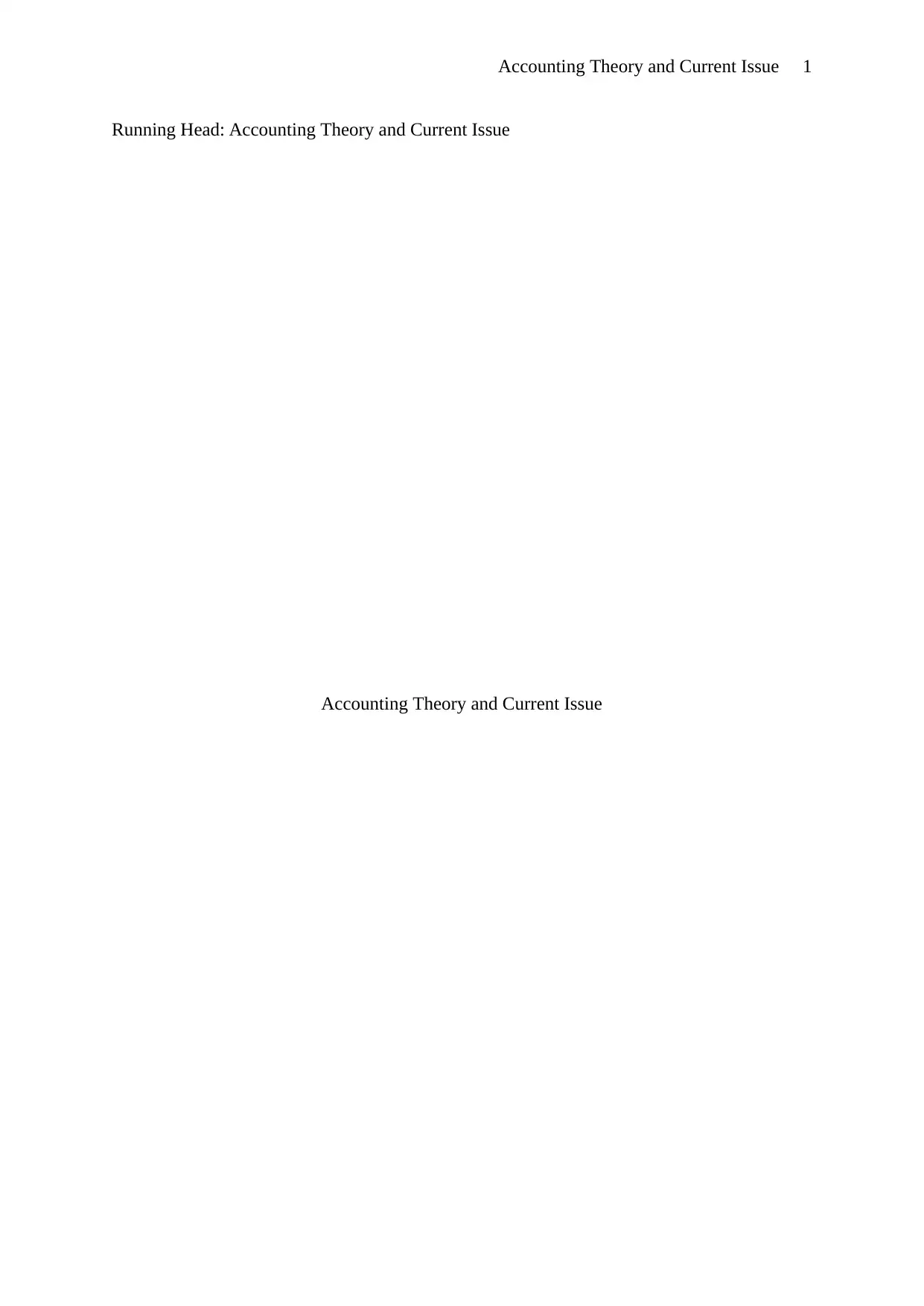
Accounting Theory and Current Issue 1
Running Head: Accounting Theory and Current Issue
Accounting Theory and Current Issue
Running Head: Accounting Theory and Current Issue
Accounting Theory and Current Issue
Paraphrase This Document
Need a fresh take? Get an instant paraphrase of this document with our AI Paraphraser
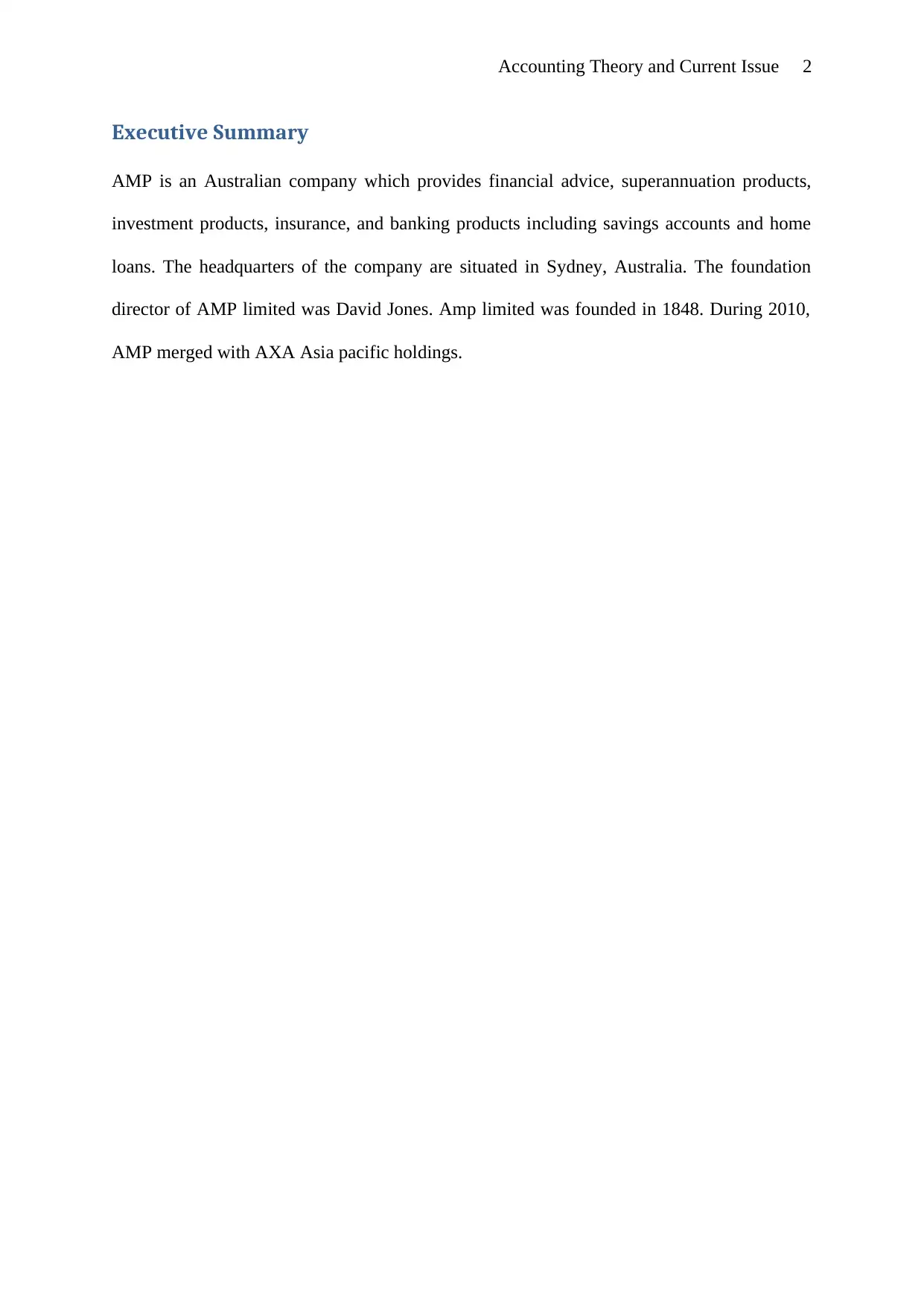
Accounting Theory and Current Issue 2
Executive Summary
AMP is an Australian company which provides financial advice, superannuation products,
investment products, insurance, and banking products including savings accounts and home
loans. The headquarters of the company are situated in Sydney, Australia. The foundation
director of AMP limited was David Jones. Amp limited was founded in 1848. During 2010,
AMP merged with AXA Asia pacific holdings.
Executive Summary
AMP is an Australian company which provides financial advice, superannuation products,
investment products, insurance, and banking products including savings accounts and home
loans. The headquarters of the company are situated in Sydney, Australia. The foundation
director of AMP limited was David Jones. Amp limited was founded in 1848. During 2010,
AMP merged with AXA Asia pacific holdings.
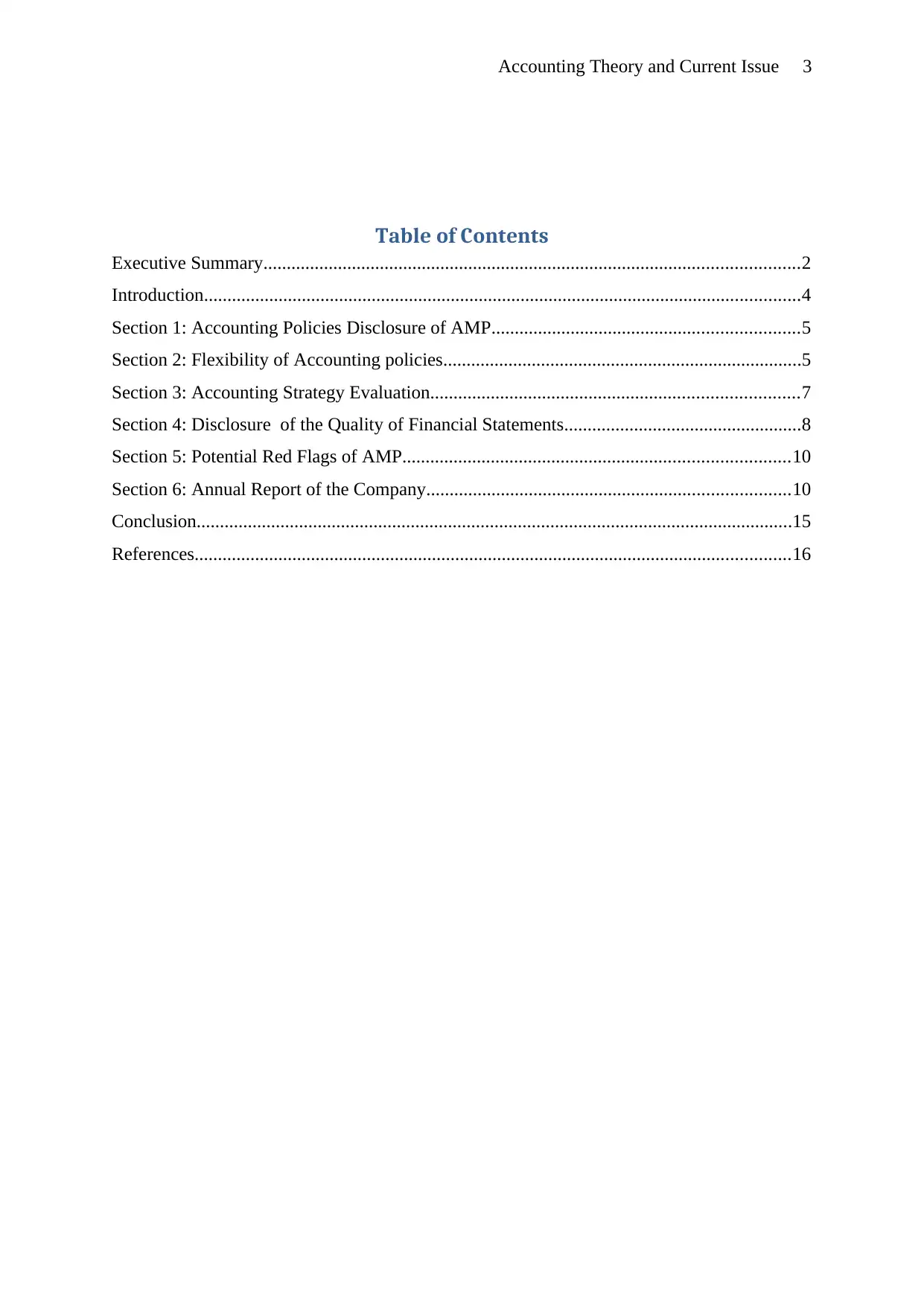
Accounting Theory and Current Issue 3
Table of Contents
Executive Summary...................................................................................................................2
Introduction................................................................................................................................4
Section 1: Accounting Policies Disclosure of AMP..................................................................5
Section 2: Flexibility of Accounting policies.............................................................................5
Section 3: Accounting Strategy Evaluation...............................................................................7
Section 4: Disclosure of the Quality of Financial Statements...................................................8
Section 5: Potential Red Flags of AMP...................................................................................10
Section 6: Annual Report of the Company..............................................................................10
Conclusion................................................................................................................................15
References................................................................................................................................16
Table of Contents
Executive Summary...................................................................................................................2
Introduction................................................................................................................................4
Section 1: Accounting Policies Disclosure of AMP..................................................................5
Section 2: Flexibility of Accounting policies.............................................................................5
Section 3: Accounting Strategy Evaluation...............................................................................7
Section 4: Disclosure of the Quality of Financial Statements...................................................8
Section 5: Potential Red Flags of AMP...................................................................................10
Section 6: Annual Report of the Company..............................................................................10
Conclusion................................................................................................................................15
References................................................................................................................................16
⊘ This is a preview!⊘
Do you want full access?
Subscribe today to unlock all pages.

Trusted by 1+ million students worldwide
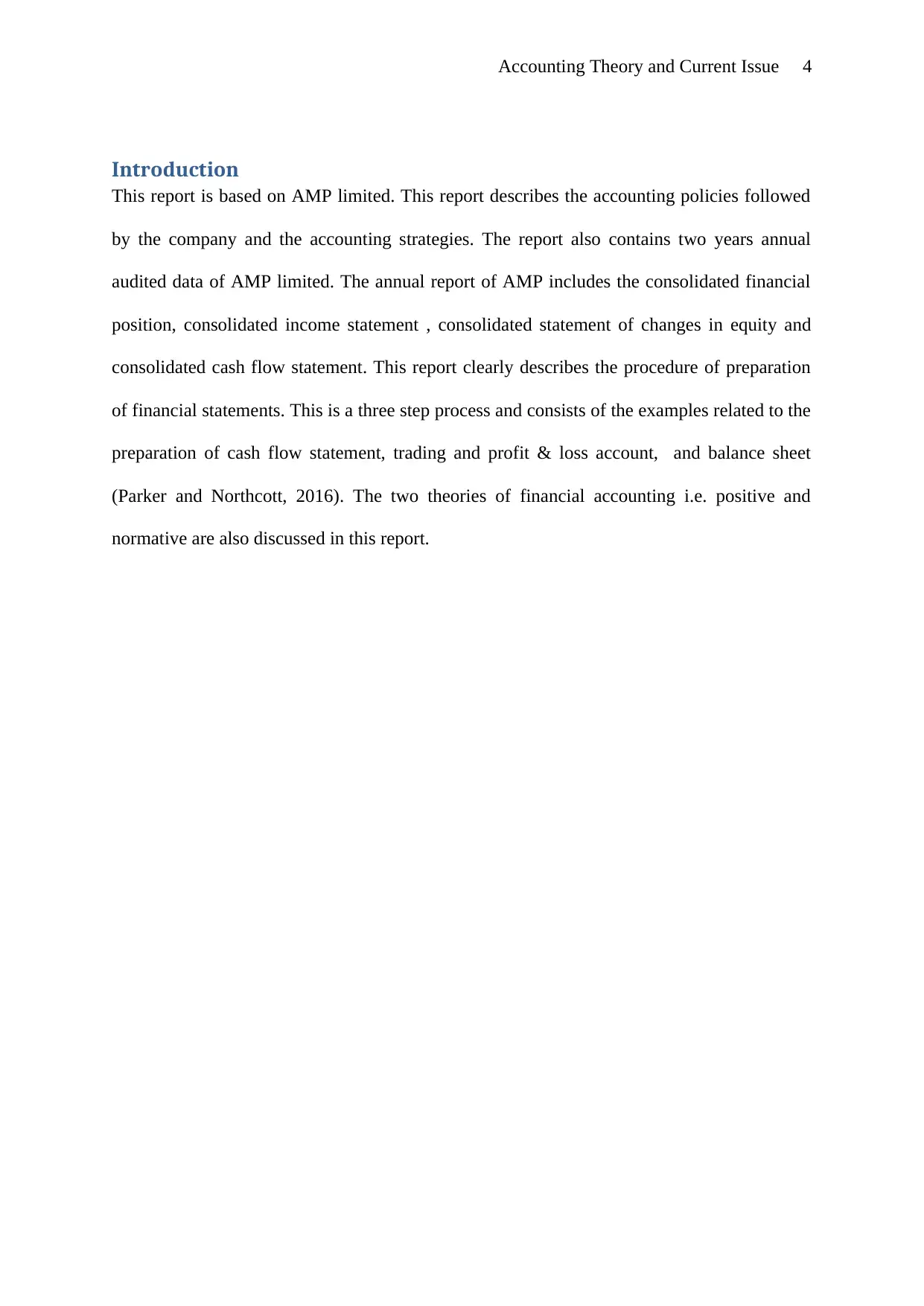
Accounting Theory and Current Issue 4
Introduction
This report is based on AMP limited. This report describes the accounting policies followed
by the company and the accounting strategies. The report also contains two years annual
audited data of AMP limited. The annual report of AMP includes the consolidated financial
position, consolidated income statement , consolidated statement of changes in equity and
consolidated cash flow statement. This report clearly describes the procedure of preparation
of financial statements. This is a three step process and consists of the examples related to the
preparation of cash flow statement, trading and profit & loss account, and balance sheet
(Parker and Northcott, 2016). The two theories of financial accounting i.e. positive and
normative are also discussed in this report.
Introduction
This report is based on AMP limited. This report describes the accounting policies followed
by the company and the accounting strategies. The report also contains two years annual
audited data of AMP limited. The annual report of AMP includes the consolidated financial
position, consolidated income statement , consolidated statement of changes in equity and
consolidated cash flow statement. This report clearly describes the procedure of preparation
of financial statements. This is a three step process and consists of the examples related to the
preparation of cash flow statement, trading and profit & loss account, and balance sheet
(Parker and Northcott, 2016). The two theories of financial accounting i.e. positive and
normative are also discussed in this report.
Paraphrase This Document
Need a fresh take? Get an instant paraphrase of this document with our AI Paraphraser
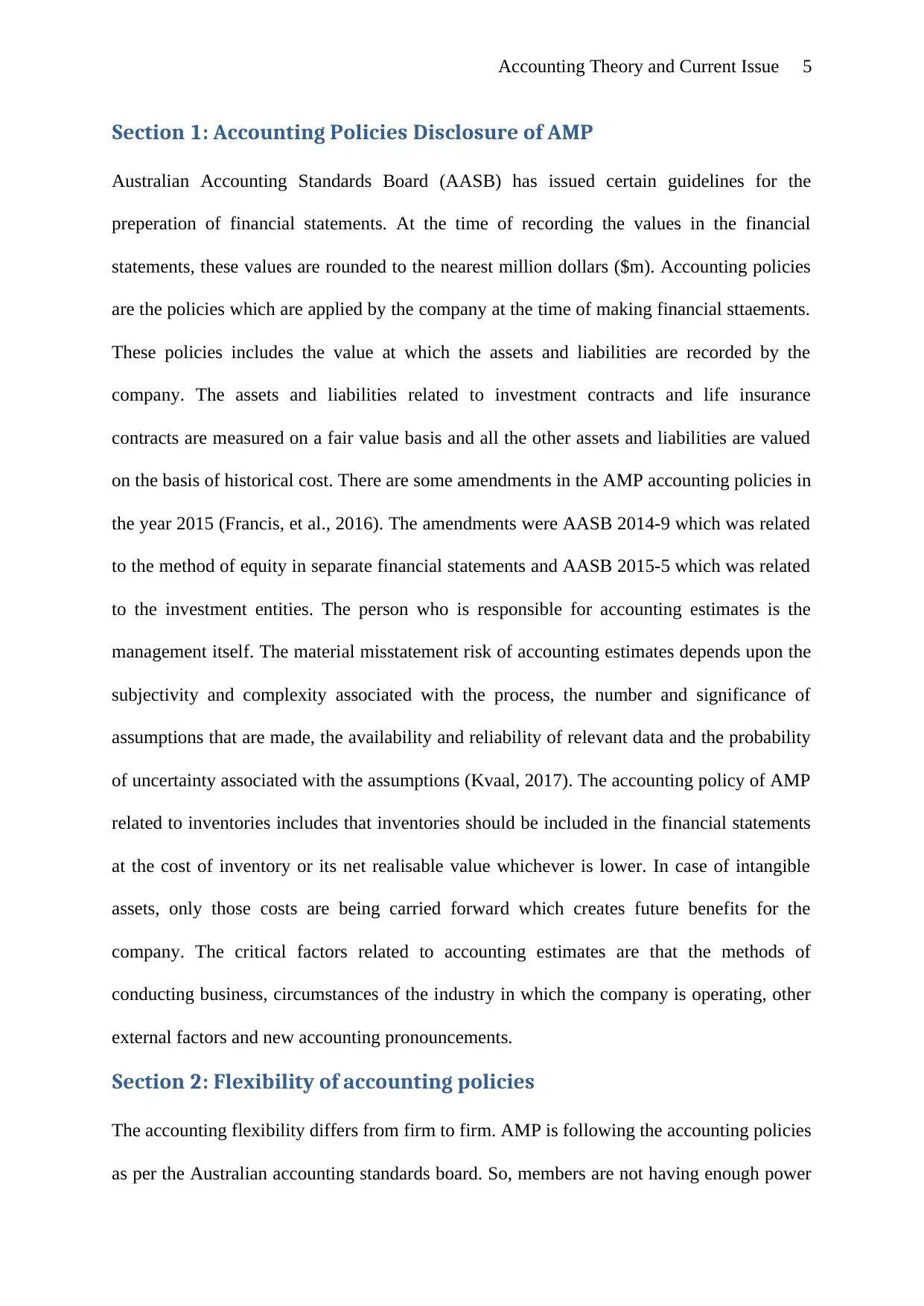
Accounting Theory and Current Issue 5
Section 1: Accounting Policies Disclosure of AMP
Australian Accounting Standards Board (AASB) has issued certain guidelines for the
preperation of financial statements. At the time of recording the values in the financial
statements, these values are rounded to the nearest million dollars ($m). Accounting policies
are the policies which are applied by the company at the time of making financial sttaements.
These policies includes the value at which the assets and liabilities are recorded by the
company. The assets and liabilities related to investment contracts and life insurance
contracts are measured on a fair value basis and all the other assets and liabilities are valued
on the basis of historical cost. There are some amendments in the AMP accounting policies in
the year 2015 (Francis, et al., 2016). The amendments were AASB 2014-9 which was related
to the method of equity in separate financial statements and AASB 2015-5 which was related
to the investment entities. The person who is responsible for accounting estimates is the
management itself. The material misstatement risk of accounting estimates depends upon the
subjectivity and complexity associated with the process, the number and significance of
assumptions that are made, the availability and reliability of relevant data and the probability
of uncertainty associated with the assumptions (Kvaal, 2017). The accounting policy of AMP
related to inventories includes that inventories should be included in the financial statements
at the cost of inventory or its net realisable value whichever is lower. In case of intangible
assets, only those costs are being carried forward which creates future benefits for the
company. The critical factors related to accounting estimates are that the methods of
conducting business, circumstances of the industry in which the company is operating, other
external factors and new accounting pronouncements.
Section 2: Flexibility of accounting policies
The accounting flexibility differs from firm to firm. AMP is following the accounting policies
as per the Australian accounting standards board. So, members are not having enough power
Section 1: Accounting Policies Disclosure of AMP
Australian Accounting Standards Board (AASB) has issued certain guidelines for the
preperation of financial statements. At the time of recording the values in the financial
statements, these values are rounded to the nearest million dollars ($m). Accounting policies
are the policies which are applied by the company at the time of making financial sttaements.
These policies includes the value at which the assets and liabilities are recorded by the
company. The assets and liabilities related to investment contracts and life insurance
contracts are measured on a fair value basis and all the other assets and liabilities are valued
on the basis of historical cost. There are some amendments in the AMP accounting policies in
the year 2015 (Francis, et al., 2016). The amendments were AASB 2014-9 which was related
to the method of equity in separate financial statements and AASB 2015-5 which was related
to the investment entities. The person who is responsible for accounting estimates is the
management itself. The material misstatement risk of accounting estimates depends upon the
subjectivity and complexity associated with the process, the number and significance of
assumptions that are made, the availability and reliability of relevant data and the probability
of uncertainty associated with the assumptions (Kvaal, 2017). The accounting policy of AMP
related to inventories includes that inventories should be included in the financial statements
at the cost of inventory or its net realisable value whichever is lower. In case of intangible
assets, only those costs are being carried forward which creates future benefits for the
company. The critical factors related to accounting estimates are that the methods of
conducting business, circumstances of the industry in which the company is operating, other
external factors and new accounting pronouncements.
Section 2: Flexibility of accounting policies
The accounting flexibility differs from firm to firm. AMP is following the accounting policies
as per the Australian accounting standards board. So, members are not having enough power
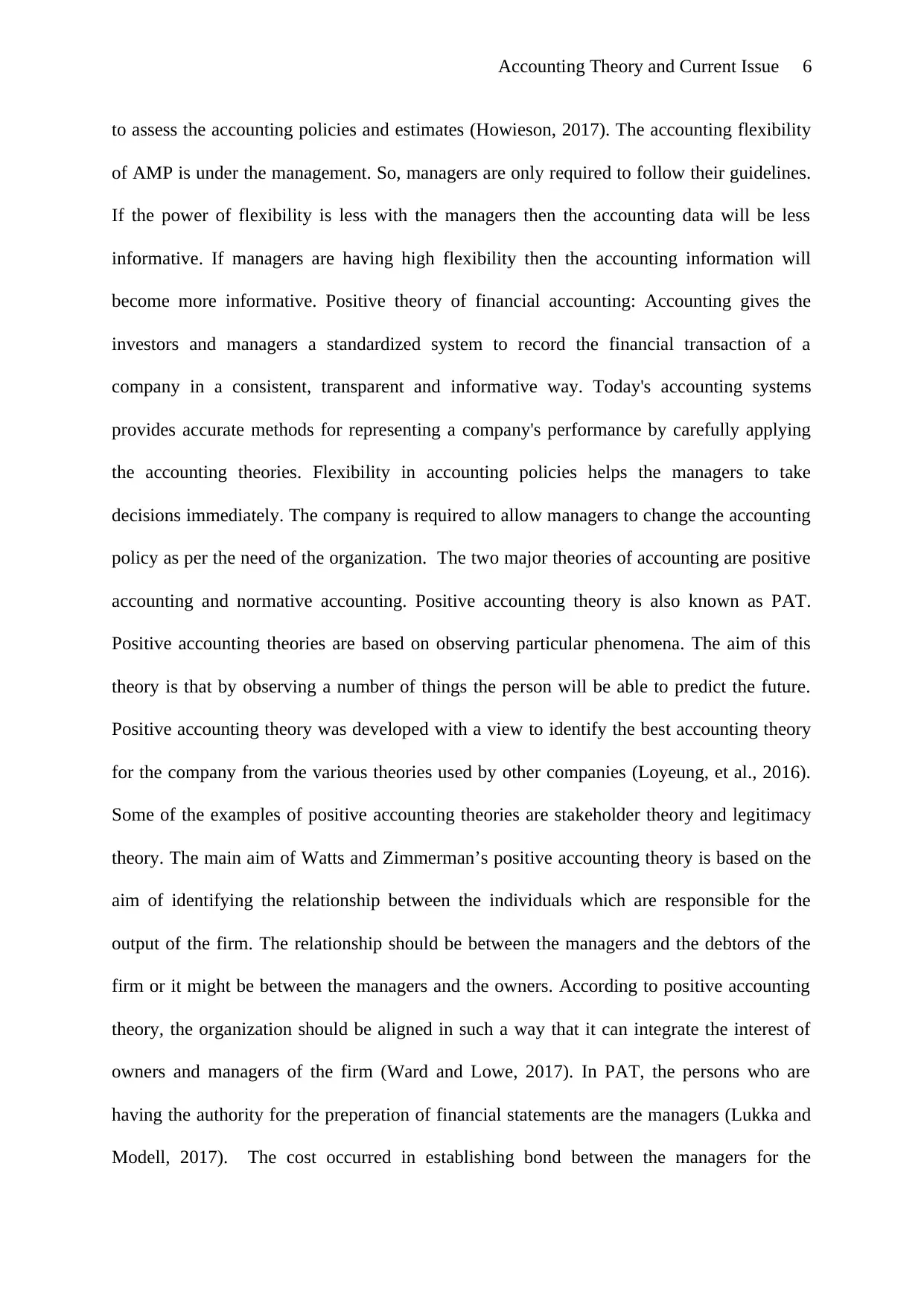
Accounting Theory and Current Issue 6
to assess the accounting policies and estimates (Howieson, 2017). The accounting flexibility
of AMP is under the management. So, managers are only required to follow their guidelines.
If the power of flexibility is less with the managers then the accounting data will be less
informative. If managers are having high flexibility then the accounting information will
become more informative. Positive theory of financial accounting: Accounting gives the
investors and managers a standardized system to record the financial transaction of a
company in a consistent, transparent and informative way. Today's accounting systems
provides accurate methods for representing a company's performance by carefully applying
the accounting theories. Flexibility in accounting policies helps the managers to take
decisions immediately. The company is required to allow managers to change the accounting
policy as per the need of the organization. The two major theories of accounting are positive
accounting and normative accounting. Positive accounting theory is also known as PAT.
Positive accounting theories are based on observing particular phenomena. The aim of this
theory is that by observing a number of things the person will be able to predict the future.
Positive accounting theory was developed with a view to identify the best accounting theory
for the company from the various theories used by other companies (Loyeung, et al., 2016).
Some of the examples of positive accounting theories are stakeholder theory and legitimacy
theory. The main aim of Watts and Zimmerman’s positive accounting theory is based on the
aim of identifying the relationship between the individuals which are responsible for the
output of the firm. The relationship should be between the managers and the debtors of the
firm or it might be between the managers and the owners. According to positive accounting
theory, the organization should be aligned in such a way that it can integrate the interest of
owners and managers of the firm (Ward and Lowe, 2017). In PAT, the persons who are
having the authority for the preperation of financial statements are the managers (Lukka and
Modell, 2017). The cost occurred in establishing bond between the managers for the
to assess the accounting policies and estimates (Howieson, 2017). The accounting flexibility
of AMP is under the management. So, managers are only required to follow their guidelines.
If the power of flexibility is less with the managers then the accounting data will be less
informative. If managers are having high flexibility then the accounting information will
become more informative. Positive theory of financial accounting: Accounting gives the
investors and managers a standardized system to record the financial transaction of a
company in a consistent, transparent and informative way. Today's accounting systems
provides accurate methods for representing a company's performance by carefully applying
the accounting theories. Flexibility in accounting policies helps the managers to take
decisions immediately. The company is required to allow managers to change the accounting
policy as per the need of the organization. The two major theories of accounting are positive
accounting and normative accounting. Positive accounting theory is also known as PAT.
Positive accounting theories are based on observing particular phenomena. The aim of this
theory is that by observing a number of things the person will be able to predict the future.
Positive accounting theory was developed with a view to identify the best accounting theory
for the company from the various theories used by other companies (Loyeung, et al., 2016).
Some of the examples of positive accounting theories are stakeholder theory and legitimacy
theory. The main aim of Watts and Zimmerman’s positive accounting theory is based on the
aim of identifying the relationship between the individuals which are responsible for the
output of the firm. The relationship should be between the managers and the debtors of the
firm or it might be between the managers and the owners. According to positive accounting
theory, the organization should be aligned in such a way that it can integrate the interest of
owners and managers of the firm (Ward and Lowe, 2017). In PAT, the persons who are
having the authority for the preperation of financial statements are the managers (Lukka and
Modell, 2017). The cost occurred in establishing bond between the managers for the
⊘ This is a preview!⊘
Do you want full access?
Subscribe today to unlock all pages.

Trusted by 1+ million students worldwide
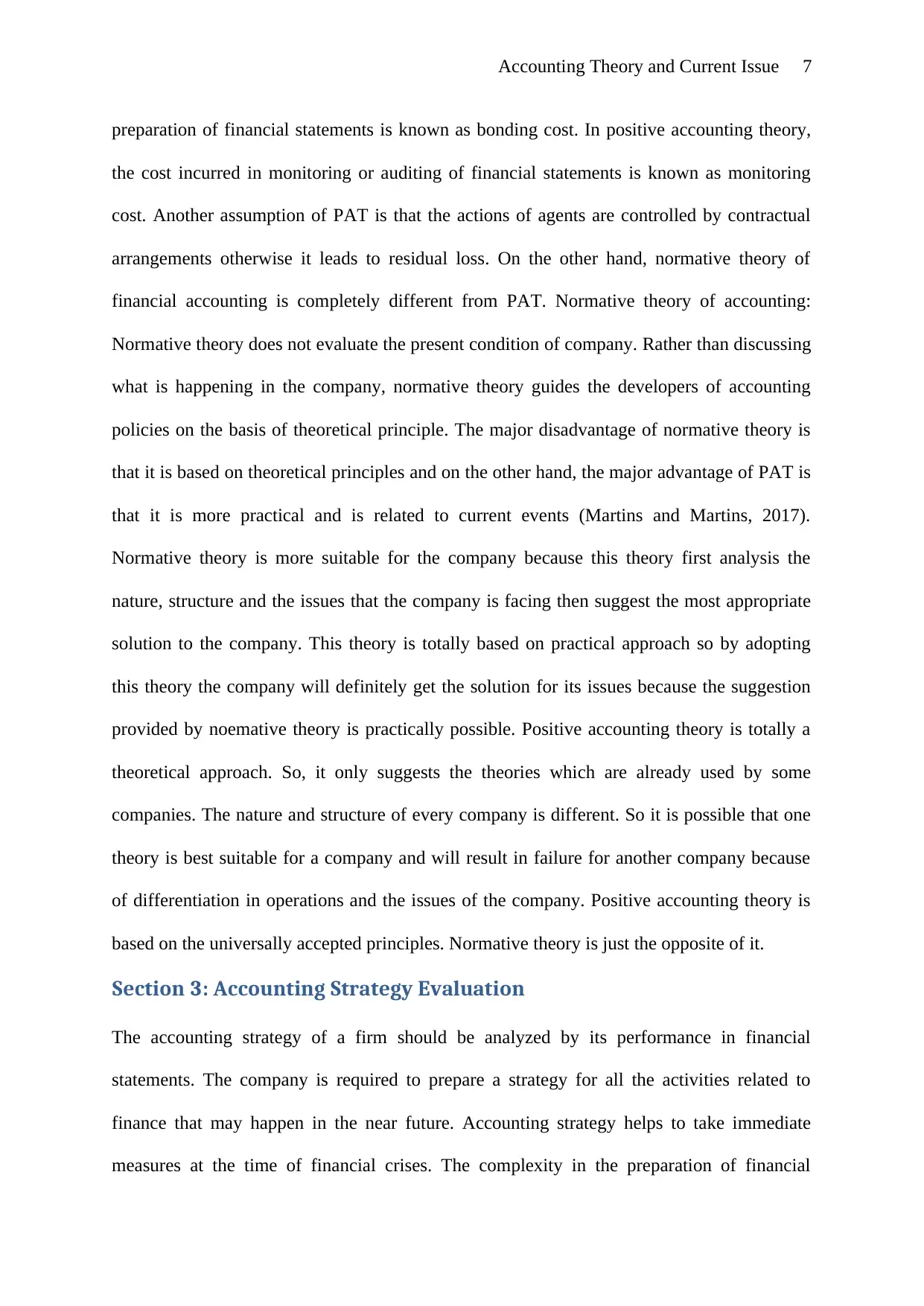
Accounting Theory and Current Issue 7
preparation of financial statements is known as bonding cost. In positive accounting theory,
the cost incurred in monitoring or auditing of financial statements is known as monitoring
cost. Another assumption of PAT is that the actions of agents are controlled by contractual
arrangements otherwise it leads to residual loss. On the other hand, normative theory of
financial accounting is completely different from PAT. Normative theory of accounting:
Normative theory does not evaluate the present condition of company. Rather than discussing
what is happening in the company, normative theory guides the developers of accounting
policies on the basis of theoretical principle. The major disadvantage of normative theory is
that it is based on theoretical principles and on the other hand, the major advantage of PAT is
that it is more practical and is related to current events (Martins and Martins, 2017).
Normative theory is more suitable for the company because this theory first analysis the
nature, structure and the issues that the company is facing then suggest the most appropriate
solution to the company. This theory is totally based on practical approach so by adopting
this theory the company will definitely get the solution for its issues because the suggestion
provided by noemative theory is practically possible. Positive accounting theory is totally a
theoretical approach. So, it only suggests the theories which are already used by some
companies. The nature and structure of every company is different. So it is possible that one
theory is best suitable for a company and will result in failure for another company because
of differentiation in operations and the issues of the company. Positive accounting theory is
based on the universally accepted principles. Normative theory is just the opposite of it.
Section 3: Accounting Strategy Evaluation
The accounting strategy of a firm should be analyzed by its performance in financial
statements. The company is required to prepare a strategy for all the activities related to
finance that may happen in the near future. Accounting strategy helps to take immediate
measures at the time of financial crises. The complexity in the preparation of financial
preparation of financial statements is known as bonding cost. In positive accounting theory,
the cost incurred in monitoring or auditing of financial statements is known as monitoring
cost. Another assumption of PAT is that the actions of agents are controlled by contractual
arrangements otherwise it leads to residual loss. On the other hand, normative theory of
financial accounting is completely different from PAT. Normative theory of accounting:
Normative theory does not evaluate the present condition of company. Rather than discussing
what is happening in the company, normative theory guides the developers of accounting
policies on the basis of theoretical principle. The major disadvantage of normative theory is
that it is based on theoretical principles and on the other hand, the major advantage of PAT is
that it is more practical and is related to current events (Martins and Martins, 2017).
Normative theory is more suitable for the company because this theory first analysis the
nature, structure and the issues that the company is facing then suggest the most appropriate
solution to the company. This theory is totally based on practical approach so by adopting
this theory the company will definitely get the solution for its issues because the suggestion
provided by noemative theory is practically possible. Positive accounting theory is totally a
theoretical approach. So, it only suggests the theories which are already used by some
companies. The nature and structure of every company is different. So it is possible that one
theory is best suitable for a company and will result in failure for another company because
of differentiation in operations and the issues of the company. Positive accounting theory is
based on the universally accepted principles. Normative theory is just the opposite of it.
Section 3: Accounting Strategy Evaluation
The accounting strategy of a firm should be analyzed by its performance in financial
statements. The company is required to prepare a strategy for all the activities related to
finance that may happen in the near future. Accounting strategy helps to take immediate
measures at the time of financial crises. The complexity in the preparation of financial
Paraphrase This Document
Need a fresh take? Get an instant paraphrase of this document with our AI Paraphraser
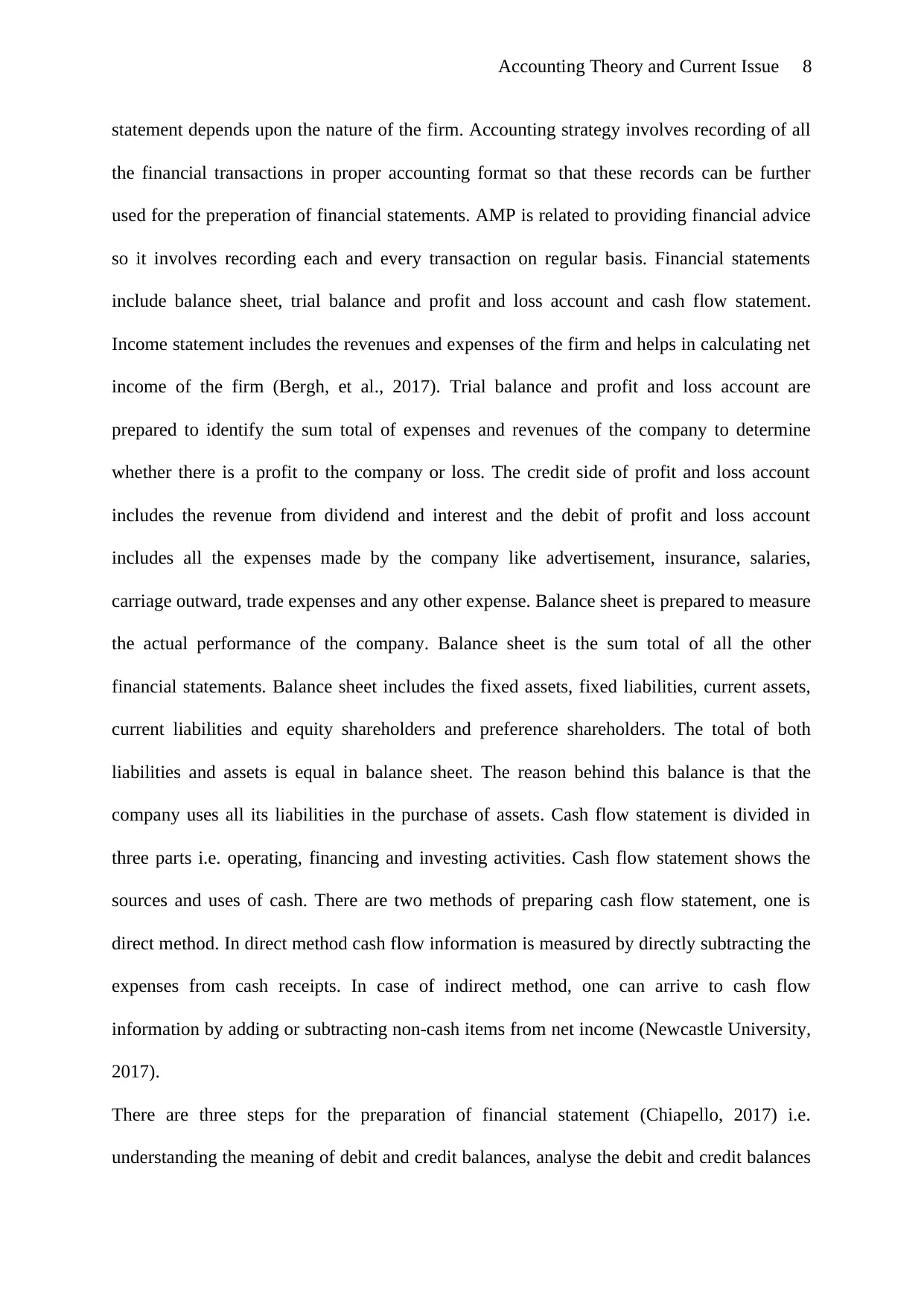
Accounting Theory and Current Issue 8
statement depends upon the nature of the firm. Accounting strategy involves recording of all
the financial transactions in proper accounting format so that these records can be further
used for the preperation of financial statements. AMP is related to providing financial advice
so it involves recording each and every transaction on regular basis. Financial statements
include balance sheet, trial balance and profit and loss account and cash flow statement.
Income statement includes the revenues and expenses of the firm and helps in calculating net
income of the firm (Bergh, et al., 2017). Trial balance and profit and loss account are
prepared to identify the sum total of expenses and revenues of the company to determine
whether there is a profit to the company or loss. The credit side of profit and loss account
includes the revenue from dividend and interest and the debit of profit and loss account
includes all the expenses made by the company like advertisement, insurance, salaries,
carriage outward, trade expenses and any other expense. Balance sheet is prepared to measure
the actual performance of the company. Balance sheet is the sum total of all the other
financial statements. Balance sheet includes the fixed assets, fixed liabilities, current assets,
current liabilities and equity shareholders and preference shareholders. The total of both
liabilities and assets is equal in balance sheet. The reason behind this balance is that the
company uses all its liabilities in the purchase of assets. Cash flow statement is divided in
three parts i.e. operating, financing and investing activities. Cash flow statement shows the
sources and uses of cash. There are two methods of preparing cash flow statement, one is
direct method. In direct method cash flow information is measured by directly subtracting the
expenses from cash receipts. In case of indirect method, one can arrive to cash flow
information by adding or subtracting non-cash items from net income (Newcastle University,
2017).
There are three steps for the preparation of financial statement (Chiapello, 2017) i.e.
understanding the meaning of debit and credit balances, analyse the debit and credit balances
statement depends upon the nature of the firm. Accounting strategy involves recording of all
the financial transactions in proper accounting format so that these records can be further
used for the preperation of financial statements. AMP is related to providing financial advice
so it involves recording each and every transaction on regular basis. Financial statements
include balance sheet, trial balance and profit and loss account and cash flow statement.
Income statement includes the revenues and expenses of the firm and helps in calculating net
income of the firm (Bergh, et al., 2017). Trial balance and profit and loss account are
prepared to identify the sum total of expenses and revenues of the company to determine
whether there is a profit to the company or loss. The credit side of profit and loss account
includes the revenue from dividend and interest and the debit of profit and loss account
includes all the expenses made by the company like advertisement, insurance, salaries,
carriage outward, trade expenses and any other expense. Balance sheet is prepared to measure
the actual performance of the company. Balance sheet is the sum total of all the other
financial statements. Balance sheet includes the fixed assets, fixed liabilities, current assets,
current liabilities and equity shareholders and preference shareholders. The total of both
liabilities and assets is equal in balance sheet. The reason behind this balance is that the
company uses all its liabilities in the purchase of assets. Cash flow statement is divided in
three parts i.e. operating, financing and investing activities. Cash flow statement shows the
sources and uses of cash. There are two methods of preparing cash flow statement, one is
direct method. In direct method cash flow information is measured by directly subtracting the
expenses from cash receipts. In case of indirect method, one can arrive to cash flow
information by adding or subtracting non-cash items from net income (Newcastle University,
2017).
There are three steps for the preparation of financial statement (Chiapello, 2017) i.e.
understanding the meaning of debit and credit balances, analyse the debit and credit balances
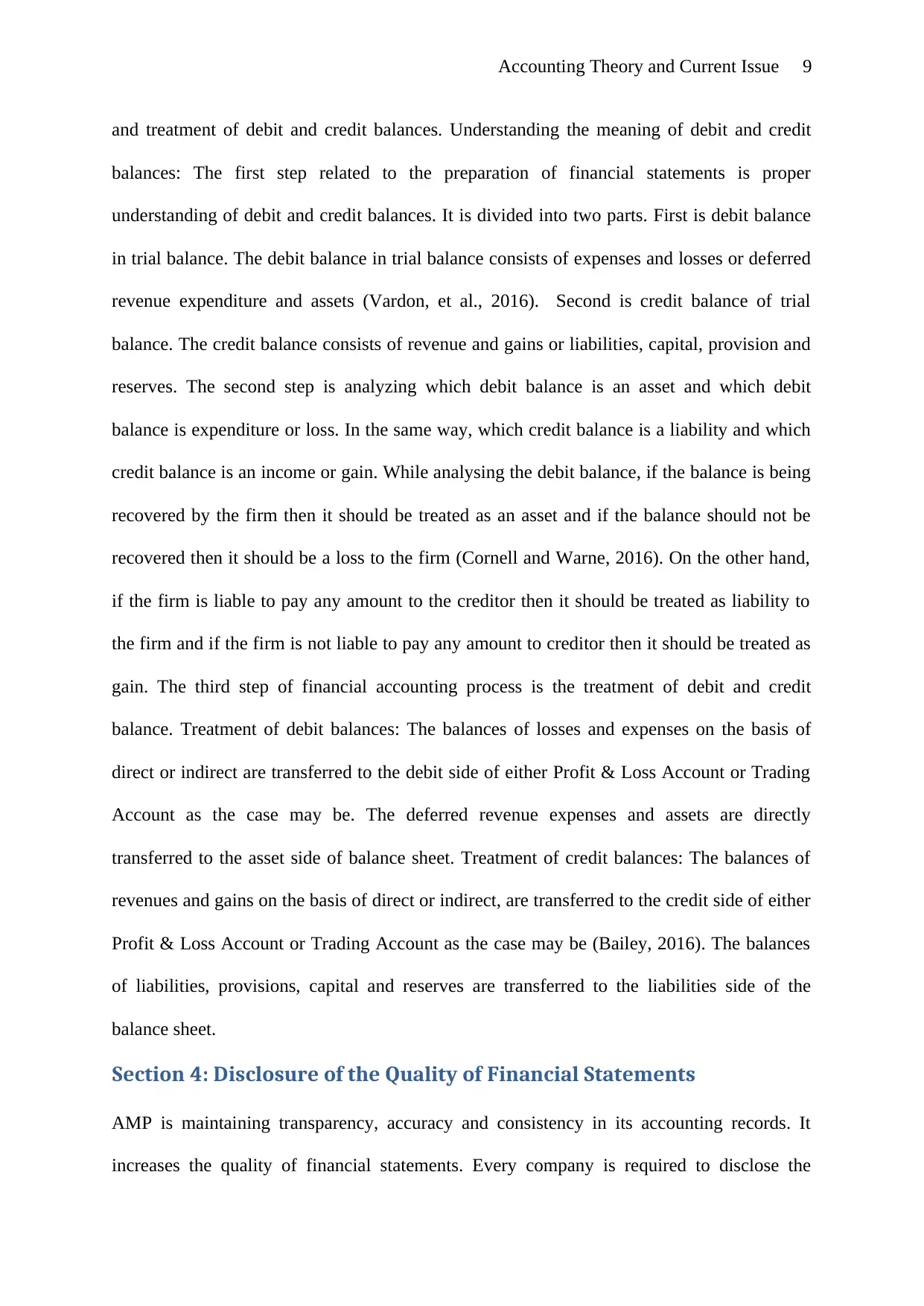
Accounting Theory and Current Issue 9
and treatment of debit and credit balances. Understanding the meaning of debit and credit
balances: The first step related to the preparation of financial statements is proper
understanding of debit and credit balances. It is divided into two parts. First is debit balance
in trial balance. The debit balance in trial balance consists of expenses and losses or deferred
revenue expenditure and assets (Vardon, et al., 2016). Second is credit balance of trial
balance. The credit balance consists of revenue and gains or liabilities, capital, provision and
reserves. The second step is analyzing which debit balance is an asset and which debit
balance is expenditure or loss. In the same way, which credit balance is a liability and which
credit balance is an income or gain. While analysing the debit balance, if the balance is being
recovered by the firm then it should be treated as an asset and if the balance should not be
recovered then it should be a loss to the firm (Cornell and Warne, 2016). On the other hand,
if the firm is liable to pay any amount to the creditor then it should be treated as liability to
the firm and if the firm is not liable to pay any amount to creditor then it should be treated as
gain. The third step of financial accounting process is the treatment of debit and credit
balance. Treatment of debit balances: The balances of losses and expenses on the basis of
direct or indirect are transferred to the debit side of either Profit & Loss Account or Trading
Account as the case may be. The deferred revenue expenses and assets are directly
transferred to the asset side of balance sheet. Treatment of credit balances: The balances of
revenues and gains on the basis of direct or indirect, are transferred to the credit side of either
Profit & Loss Account or Trading Account as the case may be (Bailey, 2016). The balances
of liabilities, provisions, capital and reserves are transferred to the liabilities side of the
balance sheet.
Section 4: Disclosure of the Quality of Financial Statements
AMP is maintaining transparency, accuracy and consistency in its accounting records. It
increases the quality of financial statements. Every company is required to disclose the
and treatment of debit and credit balances. Understanding the meaning of debit and credit
balances: The first step related to the preparation of financial statements is proper
understanding of debit and credit balances. It is divided into two parts. First is debit balance
in trial balance. The debit balance in trial balance consists of expenses and losses or deferred
revenue expenditure and assets (Vardon, et al., 2016). Second is credit balance of trial
balance. The credit balance consists of revenue and gains or liabilities, capital, provision and
reserves. The second step is analyzing which debit balance is an asset and which debit
balance is expenditure or loss. In the same way, which credit balance is a liability and which
credit balance is an income or gain. While analysing the debit balance, if the balance is being
recovered by the firm then it should be treated as an asset and if the balance should not be
recovered then it should be a loss to the firm (Cornell and Warne, 2016). On the other hand,
if the firm is liable to pay any amount to the creditor then it should be treated as liability to
the firm and if the firm is not liable to pay any amount to creditor then it should be treated as
gain. The third step of financial accounting process is the treatment of debit and credit
balance. Treatment of debit balances: The balances of losses and expenses on the basis of
direct or indirect are transferred to the debit side of either Profit & Loss Account or Trading
Account as the case may be. The deferred revenue expenses and assets are directly
transferred to the asset side of balance sheet. Treatment of credit balances: The balances of
revenues and gains on the basis of direct or indirect, are transferred to the credit side of either
Profit & Loss Account or Trading Account as the case may be (Bailey, 2016). The balances
of liabilities, provisions, capital and reserves are transferred to the liabilities side of the
balance sheet.
Section 4: Disclosure of the Quality of Financial Statements
AMP is maintaining transparency, accuracy and consistency in its accounting records. It
increases the quality of financial statements. Every company is required to disclose the
⊘ This is a preview!⊘
Do you want full access?
Subscribe today to unlock all pages.

Trusted by 1+ million students worldwide
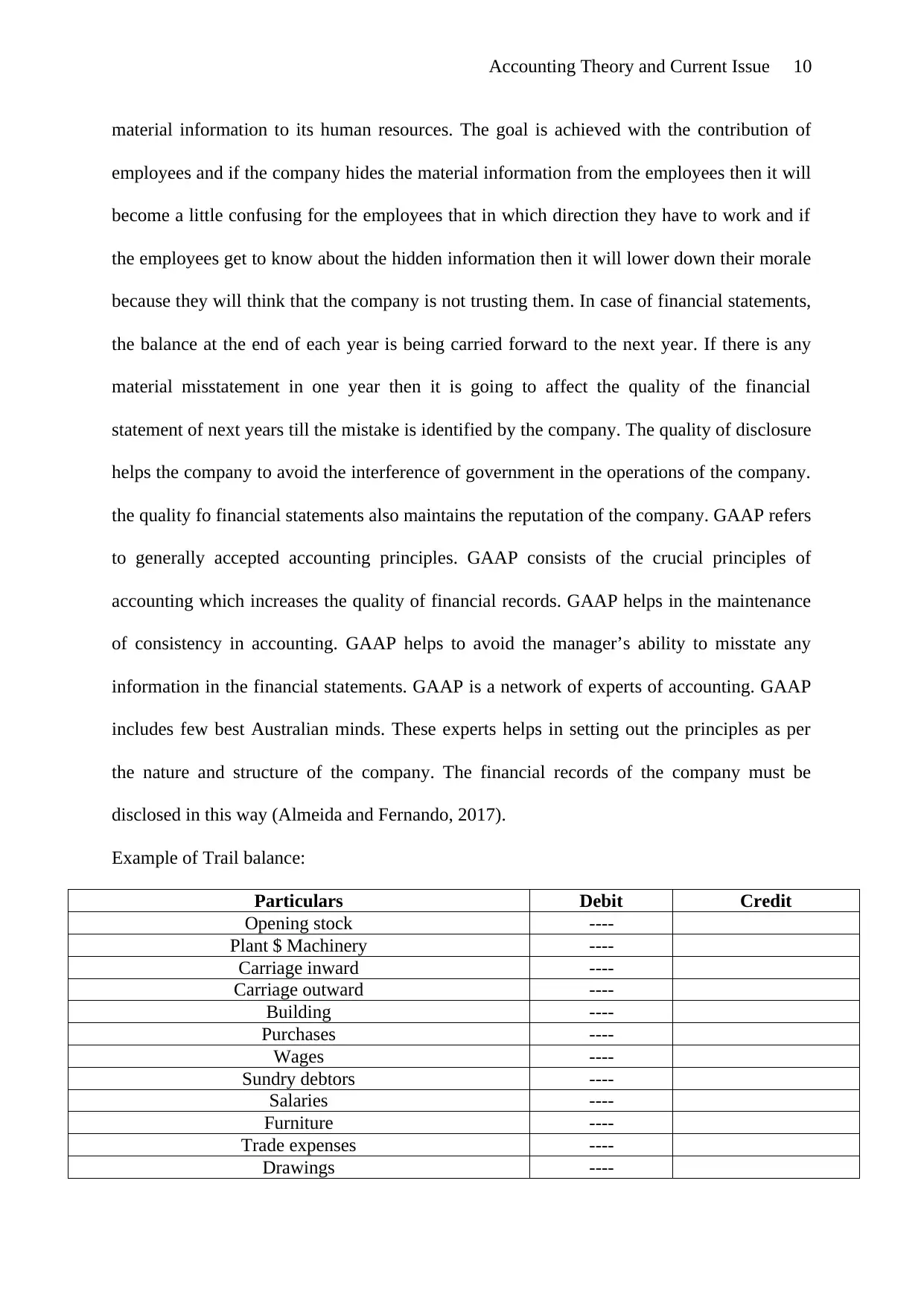
Accounting Theory and Current Issue 10
material information to its human resources. The goal is achieved with the contribution of
employees and if the company hides the material information from the employees then it will
become a little confusing for the employees that in which direction they have to work and if
the employees get to know about the hidden information then it will lower down their morale
because they will think that the company is not trusting them. In case of financial statements,
the balance at the end of each year is being carried forward to the next year. If there is any
material misstatement in one year then it is going to affect the quality of the financial
statement of next years till the mistake is identified by the company. The quality of disclosure
helps the company to avoid the interference of government in the operations of the company.
the quality fo financial statements also maintains the reputation of the company. GAAP refers
to generally accepted accounting principles. GAAP consists of the crucial principles of
accounting which increases the quality of financial records. GAAP helps in the maintenance
of consistency in accounting. GAAP helps to avoid the manager’s ability to misstate any
information in the financial statements. GAAP is a network of experts of accounting. GAAP
includes few best Australian minds. These experts helps in setting out the principles as per
the nature and structure of the company. The financial records of the company must be
disclosed in this way (Almeida and Fernando, 2017).
Example of Trail balance:
Particulars Debit Credit
Opening stock ----
Plant $ Machinery ----
Carriage inward ----
Carriage outward ----
Building ----
Purchases ----
Wages ----
Sundry debtors ----
Salaries ----
Furniture ----
Trade expenses ----
Drawings ----
material information to its human resources. The goal is achieved with the contribution of
employees and if the company hides the material information from the employees then it will
become a little confusing for the employees that in which direction they have to work and if
the employees get to know about the hidden information then it will lower down their morale
because they will think that the company is not trusting them. In case of financial statements,
the balance at the end of each year is being carried forward to the next year. If there is any
material misstatement in one year then it is going to affect the quality of the financial
statement of next years till the mistake is identified by the company. The quality of disclosure
helps the company to avoid the interference of government in the operations of the company.
the quality fo financial statements also maintains the reputation of the company. GAAP refers
to generally accepted accounting principles. GAAP consists of the crucial principles of
accounting which increases the quality of financial records. GAAP helps in the maintenance
of consistency in accounting. GAAP helps to avoid the manager’s ability to misstate any
information in the financial statements. GAAP is a network of experts of accounting. GAAP
includes few best Australian minds. These experts helps in setting out the principles as per
the nature and structure of the company. The financial records of the company must be
disclosed in this way (Almeida and Fernando, 2017).
Example of Trail balance:
Particulars Debit Credit
Opening stock ----
Plant $ Machinery ----
Carriage inward ----
Carriage outward ----
Building ----
Purchases ----
Wages ----
Sundry debtors ----
Salaries ----
Furniture ----
Trade expenses ----
Drawings ----
Paraphrase This Document
Need a fresh take? Get an instant paraphrase of this document with our AI Paraphraser
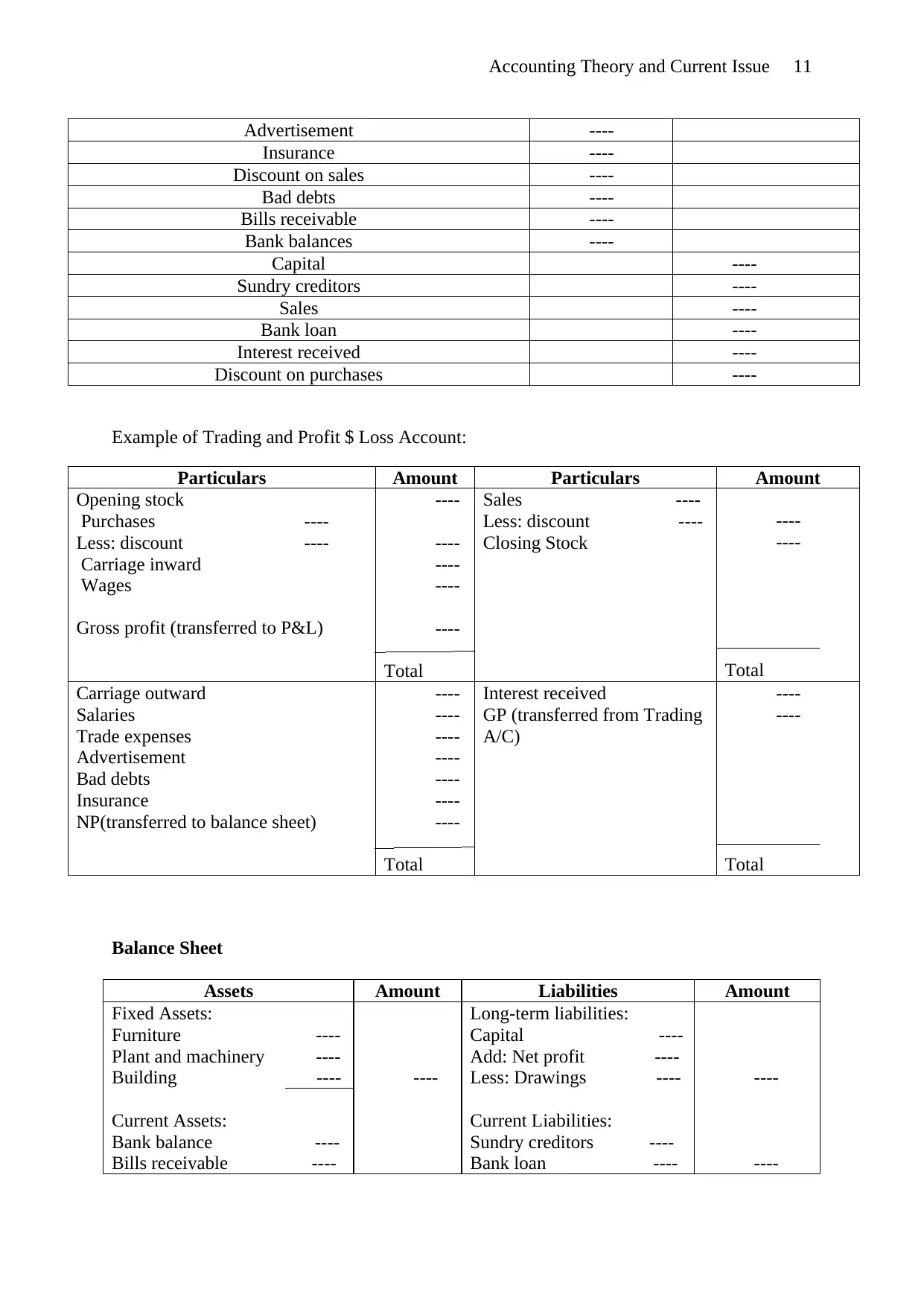
Accounting Theory and Current Issue 11
Advertisement ----
Insurance ----
Discount on sales ----
Bad debts ----
Bills receivable ----
Bank balances ----
Capital ----
Sundry creditors ----
Sales ----
Bank loan ----
Interest received ----
Discount on purchases ----
Example of Trading and Profit $ Loss Account:
Particulars Amount Particulars Amount
Opening stock
Purchases ----
Less: discount ----
Carriage inward
Wages
Gross profit (transferred to P&L)
----
----
----
----
----
Total
Sales ----
Less: discount ----
Closing Stock
----
----
Total
Carriage outward
Salaries
Trade expenses
Advertisement
Bad debts
Insurance
NP(transferred to balance sheet)
----
----
----
----
----
----
----
Total
Interest received
GP (transferred from Trading
A/C)
----
----
Total
Balance Sheet
Assets Amount Liabilities Amount
Fixed Assets:
Furniture ----
Plant and machinery ----
Building ----
Current Assets:
Bank balance ----
Bills receivable ----
----
Long-term liabilities:
Capital ----
Add: Net profit ----
Less: Drawings ----
Current Liabilities:
Sundry creditors ----
Bank loan ----
----
----
Advertisement ----
Insurance ----
Discount on sales ----
Bad debts ----
Bills receivable ----
Bank balances ----
Capital ----
Sundry creditors ----
Sales ----
Bank loan ----
Interest received ----
Discount on purchases ----
Example of Trading and Profit $ Loss Account:
Particulars Amount Particulars Amount
Opening stock
Purchases ----
Less: discount ----
Carriage inward
Wages
Gross profit (transferred to P&L)
----
----
----
----
----
Total
Sales ----
Less: discount ----
Closing Stock
----
----
Total
Carriage outward
Salaries
Trade expenses
Advertisement
Bad debts
Insurance
NP(transferred to balance sheet)
----
----
----
----
----
----
----
Total
Interest received
GP (transferred from Trading
A/C)
----
----
Total
Balance Sheet
Assets Amount Liabilities Amount
Fixed Assets:
Furniture ----
Plant and machinery ----
Building ----
Current Assets:
Bank balance ----
Bills receivable ----
----
Long-term liabilities:
Capital ----
Add: Net profit ----
Less: Drawings ----
Current Liabilities:
Sundry creditors ----
Bank loan ----
----
----
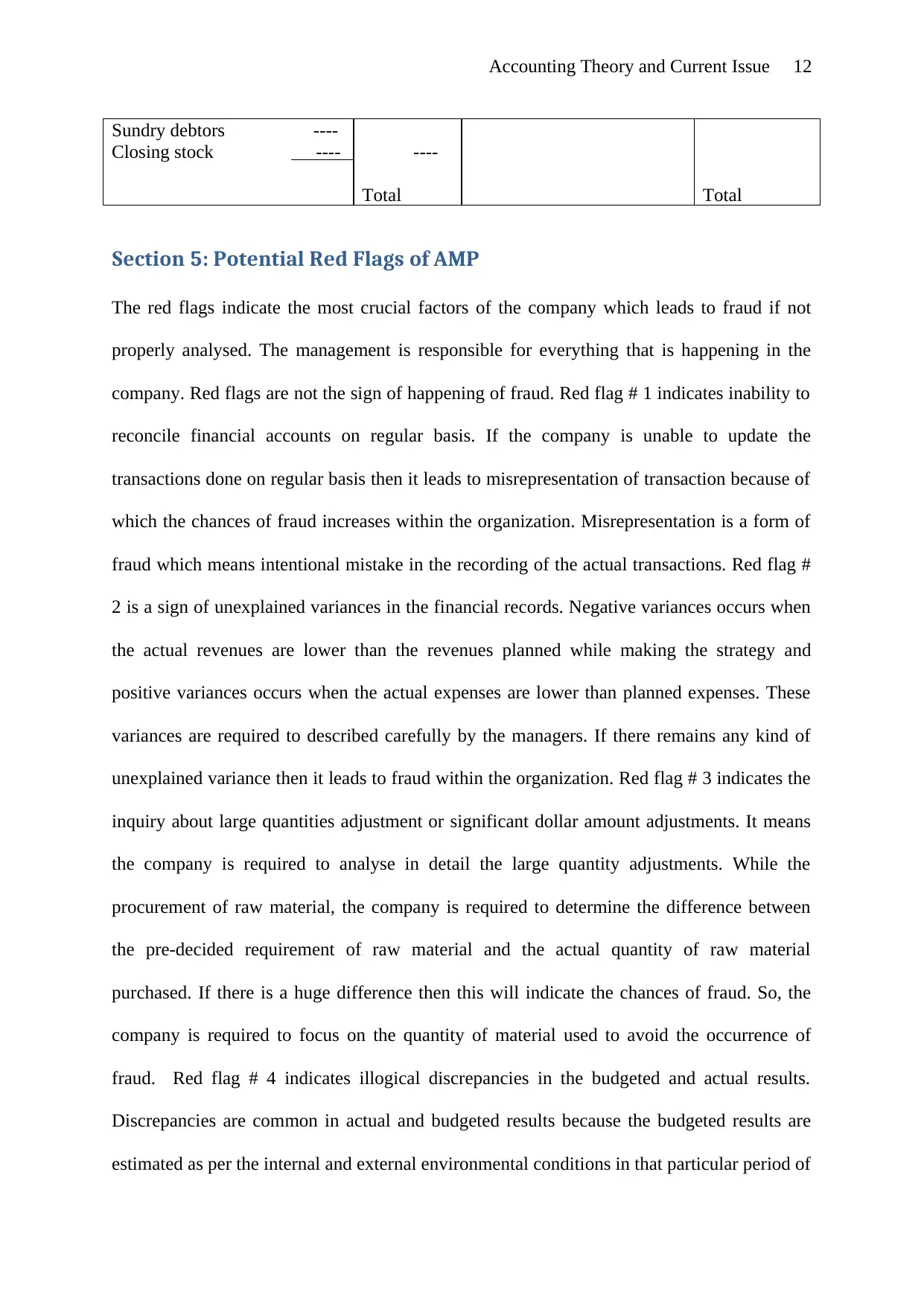
Accounting Theory and Current Issue 12
Sundry debtors ----
Closing stock ---- ----
Total Total
Section 5: Potential Red Flags of AMP
The red flags indicate the most crucial factors of the company which leads to fraud if not
properly analysed. The management is responsible for everything that is happening in the
company. Red flags are not the sign of happening of fraud. Red flag # 1 indicates inability to
reconcile financial accounts on regular basis. If the company is unable to update the
transactions done on regular basis then it leads to misrepresentation of transaction because of
which the chances of fraud increases within the organization. Misrepresentation is a form of
fraud which means intentional mistake in the recording of the actual transactions. Red flag #
2 is a sign of unexplained variances in the financial records. Negative variances occurs when
the actual revenues are lower than the revenues planned while making the strategy and
positive variances occurs when the actual expenses are lower than planned expenses. These
variances are required to described carefully by the managers. If there remains any kind of
unexplained variance then it leads to fraud within the organization. Red flag # 3 indicates the
inquiry about large quantities adjustment or significant dollar amount adjustments. It means
the company is required to analyse in detail the large quantity adjustments. While the
procurement of raw material, the company is required to determine the difference between
the pre-decided requirement of raw material and the actual quantity of raw material
purchased. If there is a huge difference then this will indicate the chances of fraud. So, the
company is required to focus on the quantity of material used to avoid the occurrence of
fraud. Red flag # 4 indicates illogical discrepancies in the budgeted and actual results.
Discrepancies are common in actual and budgeted results because the budgeted results are
estimated as per the internal and external environmental conditions in that particular period of
Sundry debtors ----
Closing stock ---- ----
Total Total
Section 5: Potential Red Flags of AMP
The red flags indicate the most crucial factors of the company which leads to fraud if not
properly analysed. The management is responsible for everything that is happening in the
company. Red flags are not the sign of happening of fraud. Red flag # 1 indicates inability to
reconcile financial accounts on regular basis. If the company is unable to update the
transactions done on regular basis then it leads to misrepresentation of transaction because of
which the chances of fraud increases within the organization. Misrepresentation is a form of
fraud which means intentional mistake in the recording of the actual transactions. Red flag #
2 is a sign of unexplained variances in the financial records. Negative variances occurs when
the actual revenues are lower than the revenues planned while making the strategy and
positive variances occurs when the actual expenses are lower than planned expenses. These
variances are required to described carefully by the managers. If there remains any kind of
unexplained variance then it leads to fraud within the organization. Red flag # 3 indicates the
inquiry about large quantities adjustment or significant dollar amount adjustments. It means
the company is required to analyse in detail the large quantity adjustments. While the
procurement of raw material, the company is required to determine the difference between
the pre-decided requirement of raw material and the actual quantity of raw material
purchased. If there is a huge difference then this will indicate the chances of fraud. So, the
company is required to focus on the quantity of material used to avoid the occurrence of
fraud. Red flag # 4 indicates illogical discrepancies in the budgeted and actual results.
Discrepancies are common in actual and budgeted results because the budgeted results are
estimated as per the internal and external environmental conditions in that particular period of
⊘ This is a preview!⊘
Do you want full access?
Subscribe today to unlock all pages.

Trusted by 1+ million students worldwide
1 out of 21
Related Documents
Your All-in-One AI-Powered Toolkit for Academic Success.
+13062052269
info@desklib.com
Available 24*7 on WhatsApp / Email
![[object Object]](/_next/static/media/star-bottom.7253800d.svg)
Unlock your academic potential
Copyright © 2020–2025 A2Z Services. All Rights Reserved. Developed and managed by ZUCOL.




